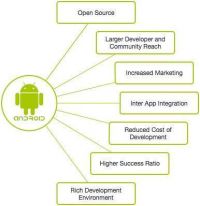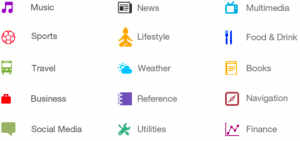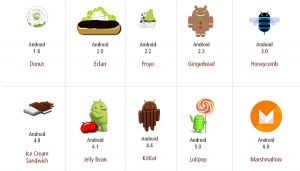Difference between revisions of "ANDROID: Overview"
Onnowpurbo (talk | contribs) (Created page with "What is Android? Who I Am Android is an open source and Linux-based Operating System for mobile devices such as smartphones and tablet computers. Android was developed by the...") |
Onnowpurbo (talk | contribs) |
||
| (13 intermediate revisions by the same user not shown) | |||
| Line 1: | Line 1: | ||
| − | + | ==Apakah Android?== | |
| − | |||
| − | |||
| − | Android | + | Android adalah Sistem Operasi open source dan berbasis Linux untuk perangkat mobile seperti smartphone dan komputer tablet. Android dikembangkan oleh Open Handset Alliance, dipimpin oleh Google, dan perusahaan lain. |
| − | + | Android menawarkan pendekatan terpadu untuk pengembangan aplikasi untuk perangkat seluler yang berarti pengembang hanya perlu mengembangkan untuk Android, dan aplikasi mereka harus dapat berjalan di berbagai perangkat yang didukung oleh Android. | |
| − | + | Versi beta pertama dari Android Software Development Kit (SDK) dirilis oleh Google pada tahun 2007 di mana sebagai versi komersial pertama, Android 1.0, dirilis pada bulan September 2008. | |
| − | + | Pada tanggal 27 Juni 2012, pada konferensi Google I/O, Google mengumumkan versi Android berikutnya, 4.1 Jelly Bean. Jelly Bean adalah pembaruan tambahan, dengan tujuan utama untuk meningkatkan antarmuka pengguna, baik dari segi fungsionalitas maupun kinerja. | |
| − | + | Source code untuk Android tersedia di bawah lisensi perangkat lunak sumber terbuka dan gratis. Google menerbitkan sebagian besar kode di bawah Lisensi Apache versi 2.0 dan sisanya, kernel Linux berubah, di bawah GNU General Public License versi 2. | |
| − | |||
| − | |||
| − | |||
| − | + | ==Why Android ?== | |
| − | |||
| − | |||
| − | + | [[File:Why android.jpg|center|200px|thumb]] | |
| − | + | ===Fitur Android=== | |
| − | |||
| − | + | Android adalah sistem operasi yang kuat yang bersaing dengan Apple 4GS dan mendukung fitur-fitur hebat. Beberapa dari mereka tercantum di bawah ini | |
| − | 3 | + | {| class="wikitable" |
| − | + | |+ Features of Android | |
| + | |- | ||
| + | ! Sr.No. !! Feature || Description | ||
| + | |- | ||
| + | | 1 || Beautiful UI || Android OS basic screen provides a beautiful and intuitive user interface. | ||
| + | |- | ||
| + | | 2 || Connectivity|| GSM/EDGE, IDEN, CDMA, EV-DO, UMTS, Bluetooth, Wi-Fi, LTE, NFC and WiMAX. | ||
| + | |- | ||
| + | | 3 || Storage || SQLite, a lightweight relational database, is used for data storage purposes. | ||
| + | |- | ||
| + | | 4 || Media support || H.263, H.264, MPEG-4 SP, AMR, AMR-WB, AAC, HE-AAC, AAC 5.1, MP3, MIDI, Ogg Vorbis, WAV, JPEG, PNG, GIF, and BMP. | ||
| + | |- | ||
| + | | 5 || Messaging|| SMS and MMS | ||
| + | |- | ||
| + | | 6 || Web browser || Based on the open-source WebKit layout engine, coupled with Chrome's V8 JavaScript engine supporting HTML5 and CSS3. | ||
| + | |- | ||
| + | | 7 || Multi-touch || Android has native support for multi-touch which was initially made available in handsets such as the HTC Hero. | ||
| + | |- | ||
| + | | 8 || Multi-tasking || User can jump from one task to another and same time various application can run simultaneously. | ||
| + | |- | ||
| + | | 9 || Resizable widgets || Widgets are resizable, so users can expand them to show more content or shrink them to save space. | ||
| + | |- | ||
| + | | 10 || Multi-Language || Supports single direction and bi-directional text. | ||
| + | |- | ||
| + | | 11 || GCM || Google Cloud Messaging (GCM) is a service that lets developers send short message data to their users on Android devices, without needing a proprietary sync solution. | ||
| + | |- | ||
| + | | 12 || Wi-Fi Direct || A technology that lets apps discover and pair directly, over a high-bandwidth peer-to-peer connection. | ||
| + | |- | ||
| + | | 13 || Android Beam || A popular NFC-based technology that lets users instantly share, just by touching two NFC-enabled phones together. | ||
| + | |} | ||
| − | + | ==Aplikasi Android== | |
| − | + | Aplikasi Android biasanya dikembangkan dalam bahasa Java menggunakan Android Software Development Kit. | |
| − | |||
| − | + | Setelah dikembangkan, aplikasi Android dapat dikemas dengan mudah dan terjual habis baik melalui store seperti Google Play, SlideME, Opera Mobile Store, Mobango, F-droid dan Amazon Appstore. | |
| − | + | Android mendukung ratusan juta perangkat seluler di lebih dari 190 negara di seluruh dunia. Ini adalah basis terpasang terbesar dari semua platform seluler dan berkembang pesat. Setiap hari lebih dari 1 juta perangkat Android baru diaktifkan di seluruh dunia. | |
| − | |||
| − | + | Tutorial ini ditulis dengan tujuan untuk mengajari kita cara mengembangkan dan mengemas aplikasi Android. Kami akan mulai dari pengaturan lingkungan untuk pemrograman aplikasi Android dan kemudian menelusuri untuk melihat berbagai aspek aplikasi Android. | |
| − | + | ==Kategori dari Aplikasi Android== | |
| − | |||
| − | + | Ada banyak aplikasi android di pasaran. Kategori teratas adalah | |
| − | + | [[File:Categories.png|center|300px|thumb|Categories]] | |
| − | |||
| − | Android | + | ==History Android== |
| − | + | Nama code android berkisar dari A sampai N saat ini, seperti Aestro, Blender, Cupcake, Donut, Eclair, Froyo, Gingerbread, Honeycomb, Ice Cream Sandwitch, Jelly Bean, KitKat, Lollipop dan Marshmallow. Mari kita memahami sejarah android secara berurutan. | |
| − | |||
| − | |||
| − | + | [[File:Jistory.jpg|center|300px|thumb|Jistory]] | |
| − | |||
| − | + | ==Apakah API level?== | |
| − | + | API Level adalah nilai integer yang secara unik mengidentifikasi revisi API kerangka kerja yang ditawarkan oleh versi platform Android. | |
| − | |||
| − | |||
| − | |||
| − | |||
| − | |||
| − | |||
| − | |||
| − | |||
| − | |||
| − | |||
| − | |||
| − | |||
| − | |||
| − | |||
| − | |||
| − | |||
| − | |||
| − | |||
| − | |||
| − | |||
| − | |||
| − | |||
| − | |||
| − | |||
| − | |||
| − | |||
| − | |||
| − | |||
| − | |||
| − | |||
| − | |||
| − | |||
| − | |||
| − | |||
| − | |||
| − | |||
| − | |||
| − | |||
| − | |||
| − | |||
| − | |||
| − | |||
| − | |||
| − | |||
| − | |||
| − | |||
| − | |||
| − | |||
| − | |||
| − | |||
| − | |||
| − | |||
| − | |||
| − | |||
| − | |||
| − | |||
| − | |||
| − | |||
| − | |||
| − | |||
| − | |||
| − | |||
| − | |||
| − | |||
| − | |||
| − | |||
| − | |||
| − | |||
| − | |||
| − | |||
| − | |||
| − | |||
| + | {| class="wikitable" | ||
| + | |+ API revision | ||
| + | |- | ||
| + | ! Platform Version !! API Level !! VERSION_CODE | ||
| + | |- | ||
| + | | Android 6.0 || 23 || MARSHMALLOW | ||
| + | |- | ||
| + | | Android 5.1 || 22 || LOLLIPOP_MR1 | ||
| + | |- | ||
| + | | Android 5.0 || 21 || LOLLIPOP | ||
| + | |- | ||
| + | | Android 4.4W || 20 || KITKAT_WATCH KitKat for Wearables Only | ||
| + | |- | ||
| + | | Android 4.4 || 19 || KITKAT | ||
| + | |- | ||
| + | | Android 4.3 || 18 || JELLY_BEAN_MR2 | ||
| + | |- | ||
| + | | Android 4.2, 4.2.2 || 17 || JELLY_BEAN_MR1 | ||
| + | |- | ||
| + | | Android 4.1, 4.1.1 || 16 || JELLY_BEAN | ||
| + | |- | ||
| + | | Android 4.0.3, 4.0.4 || API Level adalah nilai integer yang secara unik mengidentifikasi revisi API kerangka kerja yang ditawarkan oleh versi platform Android.15 || ICE_CREAM_SANDWICH_MR1 | ||
| + | |- | ||
| + | | Android 4.0, 4.0.1, 4.0.2 || 14 || ICE_CREAM_SANDWICH | ||
| + | |- | ||
| + | | Android 3.2 || 13 || HONEYCOMB_MR2 | ||
| + | |- | ||
| + | | Android 3.1.x || 12 || HONEYCOMB_MR1 | ||
| + | |- | ||
| + | | Android 3.0.x || 11 || HONEYCOMB | ||
| + | |- | ||
| + | | Android 2.3.4 || || | ||
| + | |- | ||
| + | | Android 2.3.3 || || | ||
| + | |- | ||
| + | | Android 2.3.2 || 10 || GINGERBREAD_MR1 | ||
| + | |- | ||
| + | | Android 2.3.1 || || | ||
| + | |- | ||
| + | | Android 2.3 || 9 || GINGERBREAD | ||
| + | |- | ||
| + | | Android 2.2.x || 8 || FROYO | ||
| + | |- | ||
| + | | Android 2.1.x || 7 || ECLAIR_MR1 | ||
| + | |- | ||
| + | | Android 2.0.1 || 6 || ECLAIR_0_1 | ||
| + | |- | ||
| + | | Android 2.0 || 5 || ECLAIR | ||
| + | |- | ||
| + | | Android 1.6 || 4 || DONUT | ||
| + | |- | ||
| + | | Android 1.5 || 3 || CUPCAKE | ||
| + | |- | ||
| + | | Android 1.1 || 2 || BASE_1_1 | ||
| + | |- | ||
| + | | Android 1.0 || 1 || BASE | ||
| + | |} | ||
==Referensi== | ==Referensi== | ||
* https://www.tutorialspoint.com/android/android_overview.htm | * https://www.tutorialspoint.com/android/android_overview.htm | ||
Latest revision as of 10:27, 8 June 2022
Apakah Android?
Android adalah Sistem Operasi open source dan berbasis Linux untuk perangkat mobile seperti smartphone dan komputer tablet. Android dikembangkan oleh Open Handset Alliance, dipimpin oleh Google, dan perusahaan lain.
Android menawarkan pendekatan terpadu untuk pengembangan aplikasi untuk perangkat seluler yang berarti pengembang hanya perlu mengembangkan untuk Android, dan aplikasi mereka harus dapat berjalan di berbagai perangkat yang didukung oleh Android.
Versi beta pertama dari Android Software Development Kit (SDK) dirilis oleh Google pada tahun 2007 di mana sebagai versi komersial pertama, Android 1.0, dirilis pada bulan September 2008.
Pada tanggal 27 Juni 2012, pada konferensi Google I/O, Google mengumumkan versi Android berikutnya, 4.1 Jelly Bean. Jelly Bean adalah pembaruan tambahan, dengan tujuan utama untuk meningkatkan antarmuka pengguna, baik dari segi fungsionalitas maupun kinerja.
Source code untuk Android tersedia di bawah lisensi perangkat lunak sumber terbuka dan gratis. Google menerbitkan sebagian besar kode di bawah Lisensi Apache versi 2.0 dan sisanya, kernel Linux berubah, di bawah GNU General Public License versi 2.
Why Android ?
Fitur Android
Android adalah sistem operasi yang kuat yang bersaing dengan Apple 4GS dan mendukung fitur-fitur hebat. Beberapa dari mereka tercantum di bawah ini
| Sr.No. | Feature | Description |
|---|---|---|
| 1 | Beautiful UI | Android OS basic screen provides a beautiful and intuitive user interface. |
| 2 | Connectivity | GSM/EDGE, IDEN, CDMA, EV-DO, UMTS, Bluetooth, Wi-Fi, LTE, NFC and WiMAX. |
| 3 | Storage | SQLite, a lightweight relational database, is used for data storage purposes. |
| 4 | Media support | H.263, H.264, MPEG-4 SP, AMR, AMR-WB, AAC, HE-AAC, AAC 5.1, MP3, MIDI, Ogg Vorbis, WAV, JPEG, PNG, GIF, and BMP. |
| 5 | Messaging | SMS and MMS |
| 6 | Web browser | Based on the open-source WebKit layout engine, coupled with Chrome's V8 JavaScript engine supporting HTML5 and CSS3. |
| 7 | Multi-touch | Android has native support for multi-touch which was initially made available in handsets such as the HTC Hero. |
| 8 | Multi-tasking | User can jump from one task to another and same time various application can run simultaneously. |
| 9 | Resizable widgets | Widgets are resizable, so users can expand them to show more content or shrink them to save space. |
| 10 | Multi-Language | Supports single direction and bi-directional text. |
| 11 | GCM | Google Cloud Messaging (GCM) is a service that lets developers send short message data to their users on Android devices, without needing a proprietary sync solution. |
| 12 | Wi-Fi Direct | A technology that lets apps discover and pair directly, over a high-bandwidth peer-to-peer connection. |
| 13 | Android Beam | A popular NFC-based technology that lets users instantly share, just by touching two NFC-enabled phones together. |
Aplikasi Android
Aplikasi Android biasanya dikembangkan dalam bahasa Java menggunakan Android Software Development Kit.
Setelah dikembangkan, aplikasi Android dapat dikemas dengan mudah dan terjual habis baik melalui store seperti Google Play, SlideME, Opera Mobile Store, Mobango, F-droid dan Amazon Appstore.
Android mendukung ratusan juta perangkat seluler di lebih dari 190 negara di seluruh dunia. Ini adalah basis terpasang terbesar dari semua platform seluler dan berkembang pesat. Setiap hari lebih dari 1 juta perangkat Android baru diaktifkan di seluruh dunia.
Tutorial ini ditulis dengan tujuan untuk mengajari kita cara mengembangkan dan mengemas aplikasi Android. Kami akan mulai dari pengaturan lingkungan untuk pemrograman aplikasi Android dan kemudian menelusuri untuk melihat berbagai aspek aplikasi Android.
Kategori dari Aplikasi Android
Ada banyak aplikasi android di pasaran. Kategori teratas adalah
History Android
Nama code android berkisar dari A sampai N saat ini, seperti Aestro, Blender, Cupcake, Donut, Eclair, Froyo, Gingerbread, Honeycomb, Ice Cream Sandwitch, Jelly Bean, KitKat, Lollipop dan Marshmallow. Mari kita memahami sejarah android secara berurutan.
Apakah API level?
API Level adalah nilai integer yang secara unik mengidentifikasi revisi API kerangka kerja yang ditawarkan oleh versi platform Android.
| Platform Version | API Level | VERSION_CODE |
|---|---|---|
| Android 6.0 | 23 | MARSHMALLOW |
| Android 5.1 | 22 | LOLLIPOP_MR1 |
| Android 5.0 | 21 | LOLLIPOP |
| Android 4.4W | 20 | KITKAT_WATCH KitKat for Wearables Only |
| Android 4.4 | 19 | KITKAT |
| Android 4.3 | 18 | JELLY_BEAN_MR2 |
| Android 4.2, 4.2.2 | 17 | JELLY_BEAN_MR1 |
| Android 4.1, 4.1.1 | 16 | JELLY_BEAN |
| Android 4.0.3, 4.0.4 | API Level adalah nilai integer yang secara unik mengidentifikasi revisi API kerangka kerja yang ditawarkan oleh versi platform Android.15 | ICE_CREAM_SANDWICH_MR1 |
| Android 4.0, 4.0.1, 4.0.2 | 14 | ICE_CREAM_SANDWICH |
| Android 3.2 | 13 | HONEYCOMB_MR2 |
| Android 3.1.x | 12 | HONEYCOMB_MR1 |
| Android 3.0.x | 11 | HONEYCOMB |
| Android 2.3.4 | ||
| Android 2.3.3 | ||
| Android 2.3.2 | 10 | GINGERBREAD_MR1 |
| Android 2.3.1 | ||
| Android 2.3 | 9 | GINGERBREAD |
| Android 2.2.x | 8 | FROYO |
| Android 2.1.x | 7 | ECLAIR_MR1 |
| Android 2.0.1 | 6 | ECLAIR_0_1 |
| Android 2.0 | 5 | ECLAIR |
| Android 1.6 | 4 | DONUT |
| Android 1.5 | 3 | CUPCAKE |
| Android 1.1 | 2 | BASE_1_1 |
| Android 1.0 | 1 | BASE |


